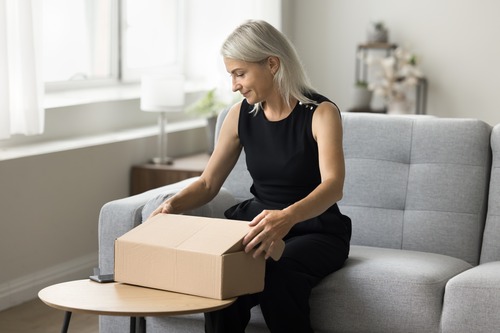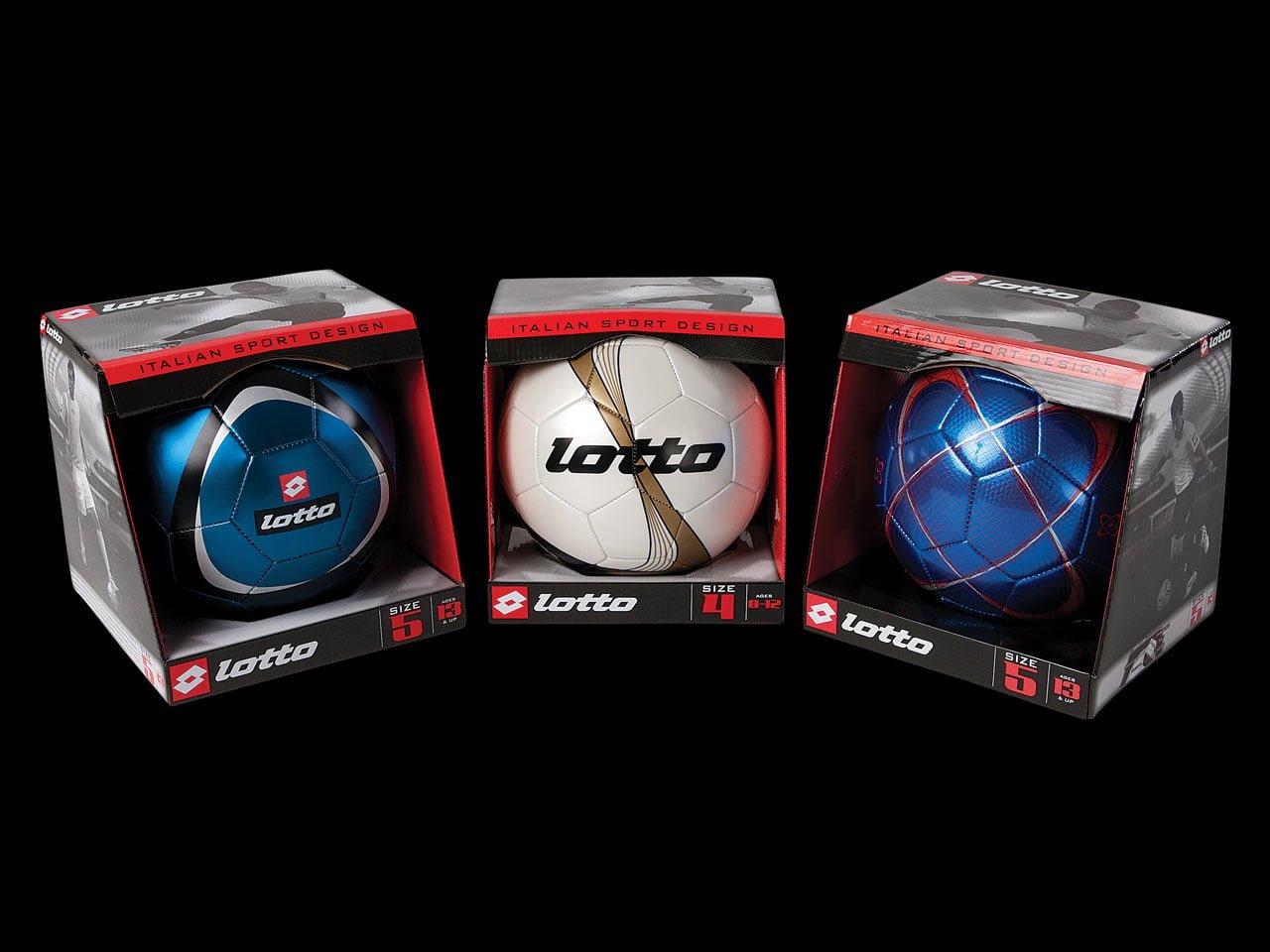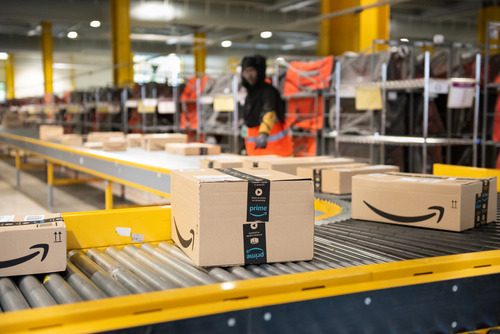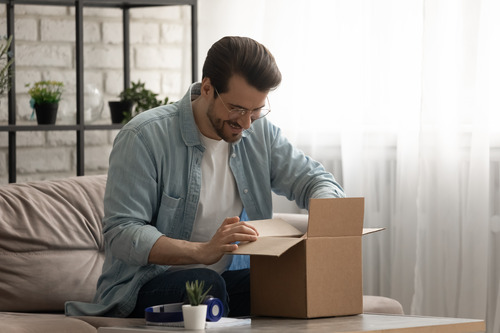Understanding Amazon Frustration-Free Packaging

Amazon’s Frustration-Free Packaging initiative emphasizes easy-to-open, 100% recyclable packaging, eliminating the need for excessive and often challenging plastic clamshells or wire ties. The program was born out of the desire to enhance the customer unboxing experience and reduce waste.
For brands and manufacturers, adhering to FFP standards means more satisfied customers and aligns with Amazon’s sustainable packaging goals, potentially leading to cost savings on packaging materials and shipping. To create packaging prototypes that meet these standards, businesses must first grasp the core principles of FFP to ensure their designs prioritize both environmental responsibility and customer convenience.
FPP standards include:
- Protective packaging that reduces damage during shipping
- Easy openability without knives, scissors, or excessive force
- Minimized excess packaging materials such as air pillows or peanuts Recyclable packaging and materials
Researching Your Product And Target Customers

Before delving into the design phase of Frustration-Free Packaging, you’ll need to understand your product's specific needs and your target customer's expectations. Every product has unique packaging requirements, from its resilience to size and shape. Pairing this understanding with insights into your customer's preferences can significantly inform the design process. For instance, luxury consumers might appreciate more rigid, high-quality materials, while tech-savvy customers might prioritize minimalist, sustainable packaging.
By marrying the practicalities of your product with the desires of your target audience, you can craft a prototype that not only adheres to Amazon's FFP guidelines but also resonates with the end user, enhancing their overall unboxing experience.
Start your FFP packaging design process by researching your product and buyer personas:
- Review product specs: weight, dimensions, fragility
- Study current packaging and identify pain points
- Survey customers on opening difficulties or damage
- Analyze Amazon reviews in your niche that mention packaging
This market research will reveal opportunities to improve your packaging for Amazon shipments. Focus on reducing steps to open, decreasing wasted space, limiting materials, and preventing product damage.
Like What You're Reading? Download a Copy As a Reference Guide To FFP.
Unlock the secrets to mastering Amazon Frustration-Free Packaging with our comprehensive guide. Fill out the form to download your free PDF and transform your packaging strategy today.
Brainstorming Packaging Design Concepts
 Once you've gathered insights into your product and target audience, the next step is to initiate a creative brainstorming process for your Frustration-Free Packaging design. This phase should be collaborative, bringing together designers, product managers, and even logistics experts to ensure aesthetic appeal and functional practicality.
Once you've gathered insights into your product and target audience, the next step is to initiate a creative brainstorming process for your Frustration-Free Packaging design. This phase should be collaborative, bringing together designers, product managers, and even logistics experts to ensure aesthetic appeal and functional practicality.
Afterward, send digital copies of your logo and any other artwork you’d like to include in your design. If you don’t have any pre-existing artwork or you want to overhaul your image, a quality printing company can work with you to find the perfect artwork. An in-house design team is a great resource that offers continuous support with art, colors, placement, and any other aesthetic concerns.
Use mood boards, sketches, or 3D modeling software to visualize various designs. Remember to prioritize easy opening mechanisms, minimal materials, and recyclability in alignment with Amazon's FFP guidelines.
By fostering an open dialogue and innovative thinking environment, you can generate multiple packaging concepts, which can then be refined and tested to ensure the final design complies with FFP standards and resonates with your brand identity and customer expectations. With all the necessary research insights, you can start ideating creative packaging approaches:
-
Sketch design concepts focusing on simplicity
-
Use CAD software or prototypes to visualize concepts
-
Consider modular, flexible, or multi-use designs
-
Experiment with alternative materials and closures
-
Maintain only essential branding elements
Explore all options. With innovative thinking, you’ll arrive at packaging that protects products and simplifies customers' experience with your packaging.
Building Physical Packaging Prototypes
After conceptualizing your design ideas, you’ll transition to the phase of building physical packaging prototypes. You can start constructing mock-ups of your packaging with materials that align with Amazon's FFP criteria, such as recyclable cardboard or biodegradable fillers.
This hands-on approach lets you interact with the package, simulating the customer's unboxing experience to identify weak points in the design, the use of excessive materials, or any difficulties opening the packaging. Moreover, these prototypes can be tested for durability during transit, ensuring the product remains protected.

Translate your ideas into physical prototypes for testing:
-
Create inexpensive prototypes with cardboard, 3D printing, etc.
-
Build multiple versions to compare alternative designs
-
Focus prototypes on closure mechanisms and access
-
Ensure adequate interior protection and partitions
-
Make prototypes durable enough for repeated testing
By physically manifesting your design ideas, you can make informed refinements, ensuring the final product aligns with FFP standards and is optimal for the end user.
Testing Packaging With Actual Users
One of the most crucial steps in the Amazon Frustration-Free Packaging design process is soliciting feedback by testing your prototypes with real users. This hands-on testing provides invaluable insights into the consumer's unboxing experience.
Ask participants to provide feedback on ease of opening, clarity of instructions (if any), and the overall functionality of the package. Observing users as they interact with your packaging highlights any design flaws or points of confusion that need to be addressed during the brainstorming and building stages.

By incorporating this real-world feedback, you ensure that your packaging meets Amazon's FFP standards and offers customers an intuitive, satisfying experience.
Real-world testing with real users allows you to:
- Recruit demographic-representative testers
- Observe them opening the prototype packaging
- Note any points of difficulty or confusion
- Survey testers on the experience
Testing will reveal usability flaws and areas for improvement. Be prepared to undergo multiple iterations until packaging meets the FFP program’s ease of use and protection requirements.
Selecting and Finalizing Packaging Design
After conducting thorough user testing and gathering feedback on your packaging prototypes, it's time to converge on a final design for your Amazon Frustration-Free Packaging. Analyze the data and observations from the testing phase, noting patterns of user preferences and any recurrent issues.
Collaborate with your design team to integrate this feedback, refining elements to enhance user experience while ensuring adherence to FFP standards. Keeping sustainability, cost-effectiveness, and production scalability in mind is essential to meeting FFP requirements. 
Once a design has been chosen, produce a high-fidelity prototype, review it critically one last time, and move forward with confidence, knowing you've developed packaging that's user-friendly, environmentally conscious, and compliant with Amazon's stringent FFP guidelines.
Having sufficient testing data will allow you to decide on your optimal packaging design:
- Determine which prototype scored highest on key criteria
- Make final refinements based on tester feedback
- Confirm that the design sufficiently protects and stabilizes the product
- Double-check compliance with Amazon FFP requirements
- Create final 3D models, specs, and prototypes
With your design finalized, you're ready for certification.
Submitting for Amazon FFP Certification

Obtaining Amazon Frustration-Free Packaging certification is a strategic move to assure customers have a seamless unboxing experience and that products align with Amazon's sustainability goals. Here's a simplified breakdown of the process to secure certification:
1. Preparation: Begin by reviewing Amazon's FFP guidelines in detail. Ensure your packaging meets key criteria: it is easy-to-open, includes recyclable materials, and contains minimal excess packaging.
2. Document Everything: As you proceed, keep detailed records of your packaging's dimensions, the materials used, and other relevant specifications. It's essential to have a comprehensive dossier of your design decisions and the packaging's features.
3. Photographic Evidence: Amazon will require high-quality images of your packaging from multiple angles. Ensure you capture clear photos that showcase how your product adheres to FFP standards.
4. Testing Protocols: Before submission, you should conduct tests based on Amazon's guidelines. This might involve drop tests, durability checks, and opening procedures to ensure the product remains intact and the unboxing process is truly frustration-free.
5. Submission Process: Once you're confident that your packaging meets FFP standards, you can formally submit your design to Amazon for review. This will involve sharing your documentation and images and sending physical samples for Amazon to evaluate.
6. Await Feedback: After submitting, patiently wait for feedback from Amazon. They might approve your packaging, request modifications, or explain why it didn't meet the criteria.
7. Revise if Necessary: If Amazon suggests changes or highlights issues, take these seriously. Modify your packaging based on their feedback and resubmit for another review.
Amazon typically contacts you within five business days to let you know whether your submission is approved. If not, requests for modifications or further testing will be provided. Securing FFP certification often takes multiple submission attempts as you iterate.
Benefitting from FFP Certified Packaging

The Amazon Frustration-Free Packaging certification is more than just a badge; it affirms your brand's commitment to enhancing the customer experience. Consumers are increasingly eco-conscious and value hassle-free unboxing.
An FFP-certified package guarantees minimal waste, easy-to-open designs, and the use of recyclable materials. By integrating FFP into your packaging strategy, you align with Amazon's sustainability goals and position your brand as forward-thinking and customer-centric.
The tangible result? Increased customer loyalty, positive product reviews, and an edge over competitors in the ever-competitive e-commerce landscape.
With Amazon's FFP seal of approval, you can:
-
Prominently display your Frustration-Free Packaging badge
-
Reduce returns and increase customer satisfaction
-
Improve organic search visibility on Amazon
-
Participate in FFP marketing promotions
-
Increase sales and Prime eligibility
But remember to maintain standards. Periodically audit your FFP packaging to ensure it continues delighting customers and driving positive experiences post-purchase.
Following this comprehensive guide will equip you to develop Amazon FFP-ready packaging successfully. Well-executed prototypes and rigorous testing are vital to creating protective, functional, and sustainable designs while delivering an outstanding unboxing experience.

